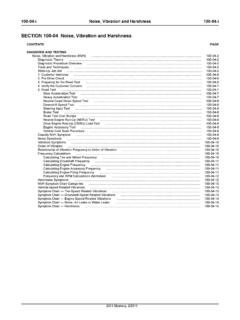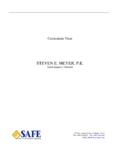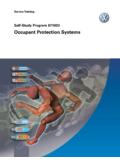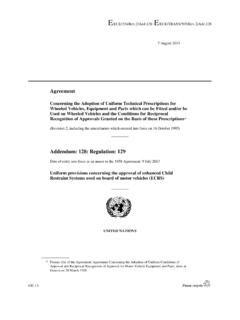Transcription of SECTION 501-20B Supplemental Restraint System
1 SECTION 501-20B Supplemental Restraint SystemCONTENTSPAGEDIAGNOSIS AND TESTINGAir Bag and Safety Belt Pretensioner Supplemental Restraint System (SRS) .. 501-20B -2 Principles of Operation .. 501-20B -2 High Speed Controller Area Network (HS-CAN) .. 501-20B -3 Impact Sensor .. 501-20B -3 Occupant Classification Sensor (OCS) System .. 501-20B -3 Belt Tension Sensor (BTS) .. 501-20B -3 Passenger Air Bag Module .. 501-20B -4 restraints Control Module (RCM) .. 501-20B -4 Safety Belt Buckle Switches .. 501-20B -4 Safety Belt Retractor Pretensioner .. 501-20B -4 Seat Track Position Sensor .. 501-20B -4 Secondary Air Bag Warning (Chime) .. 501-20B -5 Seat Side Air Bag Module .. 501-20B -5 Fault PIDs .. 501-20B -5 Lamp Fault Codes (LFCs) .. 501-20B -5 Prove Out Procedure .. 501-20B -5 Inspection and Verification .. 501-20B -5 DTC Charts .. 501-20B -6 Symptom Chart .. 501-20B -11 Pinpoint Test restraints Control Module (RCM).
2 501-20B -11 Pinpoint Test Occupant Classification System Module (OCSM) .. 501-20B -131501-20B-iSupplemental Restraint System501-20B-i2011 Mustang, 2/2011 DIAGNOSIS AND TESTINGAir Bag and Safety Belt Pretensioner Supplemental Restraint System (SRS)Special Tool(s)Flex Probe KitNUD105-R025D or equivalentFluke 77-IV Digital MultimeterFLU77-4 or equivalentVehicle Communication Module (VCM) and Integrated Diagnostic System (IDS)software with appropriate hardware, or equivalent scan toolPrinciples of OperationThe restraints Control Module (RCM) continuously receives/monitors all inputs from the following Supplemental Restraint System (SRS) components: Front impact severity sensor (frontal restraints sensor) First row side impact sensor (mounted on inner rocker panel) (left/right side restraints sensor 1) Safety belt buckle switches (driver and passenger) Driver seat track position sensor Occupant Classification System Module (OCSM)If the RCM detects sudden vehicle deceleration and/or lateral deceleration based on the information received from all sensors and switches and determinesthat deployment is required, the RCM sends voltage and current to deploy the appropriate SRS a frontal or side crash, the RCM may deploy the following SRS components, based on crash severity and sensor input.
3 Safety belt retractor pretensioner(s) Seat side air bag(s) Driver/passenger dual-stage air bag (one or both stages)The fact that the safety belt retractor pretensioner(s) or air bags did not activate for both front seat occupants in a crash does not mean that something iswrong with the RCM performs a self-test of the complete SRS during each startup. If a SRS fault exists, the air bag warning indicator will illuminate and remainilluminated for the rest of the ignition cycle. In addition to the self-test at start up, the RCM continuously monitors all of its SRS components and circuitryfor correct Bag Warning IndicatorThe air bag warning indicator: located in the Instrument Cluster (IC) module will prove out by lighting for 6 seconds and then turn off. will flash and/or illuminate based on the message the IC module receives from the RCM. will illuminate if the IC module does not receive a message from the Restraint System501-20B-22011 Mustang, 2/2011 Air Bag Module Second Stage Deployment CheckBecause the driver and passenger front air bags each have 2 deployment stages, it is possible that Stage 1 has deployed and Stage 2 has a front air bag module has deployed, it is mandatory that the front air bag module be remotely deployed using the appropriate air bag disposal procedure.
4 For information on driver air bag module and/or passenger air bag module remote deployment, refer to Pyrotechnic Device Disposal in this clockspring: allows for continuous electrical connections between the driver air bag module and the RCM when the steering wheel is Air Bag ModuleThe driver air bag module: is a dual-stage air bag, upon receiving a flow of current from the RCM, deploying at 1 of 2 different rates depending upon vehicle impact severity andsensor Notification SignalIn the event of a crash, the RCM provides an event notification signal to the fuel pump driver module(s) to disable the fuel RCM does not monitor the event notification signal circuit for faults and will not set a DTC if a fault Speed Controller Area Network (HS-CAN)This vehicle utilizes a communication System called a High Speed Controller Area Network (HS-CAN). The RCM communicates with various modules forrequired information about the vehicle.
5 Refer to SECTION 418-00 for information about the SensorThe SRS uses 3 satellite sensors in addition to the RCM. The RCM is mounted to the center tunnel beneath the console. The front impact severity sensor(frontal Restraint sensor) is located in the front of the vehicle, behind the grille mounted on the radiator support. The side impact sensors are mounted on theinner rocker panels. Mounting orientation is critical for correct operation of all impact Classification Sensor (OCS) SystemThe Occupant Classification Sensor (OCS) System is found only on the front passenger seat. The front passenger seat OCS System is comprised of a siliconegel-filled bladder mounted between the seat cushion foam and pan, a pressure sensor that is mounted to the seat frame and an OCSM which is also mountedto the seat frame. Pressure is applied to the OCS System bladder when weight of any occupant or object in the front passenger seat is present.
6 The pressure isthen transferred through a tube, is sensed by the OCS System pressure sensor, then electronically communicated to the OCSM. Based on pre-programmed setpoints, the OCSM will inform the RCM, via the HS-CAN, of the necessary information. The RCM uses this information in determining if the passenger airbag module is to be deployed in the event of a deployable crash. The RCM also uses this information to illuminate/not illuminate the Passenger Air BagDeactivation (PAD) OCSM monitors the OCS System for OCS System is also used for operation of the passenger Belt Minder . For information on the passenger Belt Minder feature, refer to Section501-20A. To deactivate or reactivate the passenger Belt Minder feature, refer to SECTION 413-01 or the Owner's Tension Sensor (BTS)The Belt Tension Sensor (BTS): is a 3-wire Hall-effect sensor located at the safety belt anchor point and is part of the front passenger safety belt and retractor assembly.
7 Is used in conjunction with the OCS BTS is used by the OCS System to identify the presence of a child safety seat on the front passenger seat. The BTS senses the tension on the safety beltassembly then provides an output to the OCSM, indicating that the safety belt assembly is cinched. After sensing the weight applied to the seat by theoccupant and using the BTS input, the OCSM determines how the occupant should be classified and communicates this information to the RCM. If theoccupant is classified as a child, the RCM will then automatically deactivate the passenger air bag module and illuminate the PAD Air Bag Deactivation (PAD) IndicatorThe restraints Control Module (RCM) controls the state of the Passenger Air Bag Deactivation (PAD) indicator through a direct hard-wire connection,based on information provided by the OCS System . An exemption to this is when the front passenger seat is determined to be empty, and therefore indicationof a deactivated passenger air bag module is not necessary.
8 In all other cases, the PAD indicator is off when the passenger air bag module is the ignition is ON, the RCM briefly activates the PAD indicator to prove out the indicator function and verify to the front occupants correct functionaloperation of the PAD following table indicates the passenger air bag status and the PAD indicator status based on the size of the front passenger Restraint System501-20B-3 DIAGNOSIS AND TESTING (Continued)2011 Mustang, 2/2011 Passenger Air Bag and Passenger Air Bag Deactivation (PAD) Indicator StatusOccupant SizePassenger Safety Belt BuckleStatusPass. Air Bag StatusPAD IndicatorNoneUnbuckledDisabledUnlitNoneB uckledDisabledLitSmallBuckled/ UnbuckledDisabledLitLargeBuckled/ UnbuckledEnabledUnlitPassenger Air Bag ModuleThe passenger air bag module: is a dual-stage air bag, deploying at 1 of 2 different rates depending upon vehicle impact severity and sensor Control Module (RCM)WARNING:If a vehicle has been in a crash, inspect the restraints control module (RCM) and the impact sensor (if equipped) mounting areas for deformation.
9 Ifdamaged, restore the mounting areas to the original production configuration. A new RCM and sensors must be installed whether or not the airbags have deployed. Failure to follow these instructions may result in serious personal injury or death in a : Carrying out Programmable Module Installation (PMI) will not enable the 911 assist option that is RCM carries out the following functions: Activates the driver, passenger and/or side air bag modules depending upon vehicle impact severity and the sensor inputs. Activates the driver and passenger retractor pretensioner(s) to control the tension of the driver and passenger safety belts in the event of a deployablecrash Monitors the SRS for faults Sends a message to the IC module to illuminate the air bag warning indicator if a fault is detected Communicates through the Data Link Connector (DLC) the current or historical DTCsThe RCM monitors the SRS for possible faults.
10 If a fault is detected, the RCM will request the IC module to illuminate the air bag warning indicator. Whenthe ignition is turned OFF and then ON, the IC module will prove out the air bag warning indicator by lighting for 6 seconds. If no faults are detected by theRCM, the IC module will turn the air bag warning indicator off and it will remain off. If the RCM detects a fault, it will send a message to the IC module toturn the air bag warning indicator on and it will remain on for the rest of the ignition cycle. If the RCM requests illumination of the air bag warning indicatorand the air bag warning indicator does not function, the IC module will automatically activate an audible chime. The chime is a series of 5 sets of 5 tonebursts. If the chime is heard, the SRS and the air bag warning indicator require RCM includes a backup power supply. This feature provides sufficient backup power to deploy the air bags in the event that the ignition circuit is lost ordamaged during impact.










